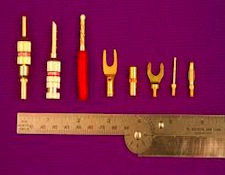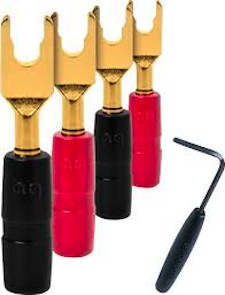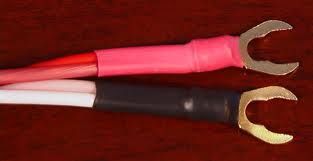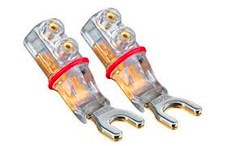It’s the time of year for saving money!

You can’t deny that one of the most contentious audiophile hot buttons is whether interconnect and speaker cable does or doesn’t make an audible difference. Equally important, but less-often discussed, is how speaker cable terminations affect sound. Ask any “serious” audiophile about cable terminations and they will, more than likely, have a strong opinion that may or may not be based on fact.
Over the course of my time as an audiophile I’ve seen and heard more cable demonstrations than I care to remember. TAD/Pioneer speaker designer Andrew Jones put one of the most striking demos I’ve seen at RMAF in 2012. His demo was a simple A/B test. He had two sets speaker connections connected to the back of a pair of TAD speakers. One connection used a WBT five-way binding post while the other used a WBT copy. Nothing else in the signal chain was altered except for the WBT and non-WBT connectors. The difference between the two connectors was audible and not subtle. And the only difference was the termination hardware. My conclusion was that even the quality of the termination has an audible effect on a system’s overall sound.

How many ways can you terminate speaker cable? Let me count the ways…first there are spade lugs, then banana plugs, Speakon connectors (which outside of pro audio sound reinforcement I’ve never seen used), Spring-loaded connection holes and small barrel connectors, and of course, bare wire.
But beyond the kind and shape of the speaker connectors used, there’s the bigger issue of how they are attached to speaker wire. Most speaker cables that are not terminated in bare wire use solder somewhere in the termination to hold stuff together. Even some bare wire comes with soldered tips just to keep all the wires from becoming unstuck.

And stick together is what solder does well, but what solder does not do well is pass electrical signal. Be it premium ultra-fi silver solder or plain old lead-based plumber’s solder, neither pass an electrical signal as well as bare metal. In fact in a well-designed termination, solder isn’t used for its transmission properties, it’s only used for its air-sealing and ability to “glue” two pieces of cable or cable hardware to one another in a way so that they will remain in tight air-sealed contact.
The most important aspect of a termination is how much wire in the cable is in direct and tight contact with the speaker connection. The tighter the connection, the less electrical resistance there will be. If you look at inexpensive speaker connections, you’ll see that they often employ a single set screw to supply all the mechanical attachment. That’s not a lot of surface area for a direct and intimate connection. If you look at a high-quality termination you’ll find a much larger surface for the wire and termination hardware to make a tight contact.

As to the question of whether a spade, banana, or bare wire connection is intrinsically better. I can’t help but think this is the wrong question. Any of these methods, if done with a good airtight connection, works fine and can sound equally good. It all comes down to the care an attention paid to the connections during construction. Premium cable manufacturers put far more time, effort, and thought into making optimal terminations, which is just one of the many reasons they cost more and last longer than the high-volume mass-market stuff.






just wanted to say that REL subwoofers use speakon connectors and they are certainly not a pro-audio & sound reinforcement company. Also, the speakon connector has extremely low contact resistance and impedance.
Everyone LOVES the speakon connector, but almost no one uses it, with a few exceptions….
Agreed.
Superb posts with lots of information!!! This is really the most
miraculous blog site dude….Welding cable
This is hysterical. This article sounds as if solder is nothing more than a nice, shiny glue used to hold wires together. “And stick together is what solder does well, but what solder does not do well is pass electrical signal.”
But did anyone of you ever measure the resistance of a piece of common 60/40 electronic solder? You should try it some time. You’ll find it passes the electrical signal quite well. That’s why they use it inside your amplifier in places like on the other side of your speaker terminals! So all this fussing on how to connect to the terminal on the outside of the amp, and yet it has solder inside the amp on same terminal because, guess what? That’s what works the best! Any crimped on connection is a mechanical connection, and anyone in electronics knows that a mechanical connection isn’t as good. I’d suggest you use spade lugs, but SOLDER THEM onto your speaker wire.
And in the future, I think I’d take any advice from Steven Stone with a grain of salt. In this article he very clearly has no idea what he’s talking about.
Crimped on is superior over solder if it is exposed to a lot of vibrations/movements. Otherwise, both are equally good assuming the solder is done correctly iaw IPC-610 standard.